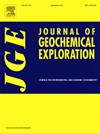Unveiling predominant and latent factors influencing the geochemical variability in a river catchment: A statistical and visual approach
IF 3.3
2区 地球科学
Q1 GEOCHEMISTRY & GEOPHYSICS
引用次数: 0
Abstract
The Sabato River catchment basin in Southern Italy was investigated to assess and understand geochemical variations affecting potentially toxic elements along its course. For this purpose, thirty-five stream sediment samples were collected in the fall of 2018 from the river's main course. The individual composition found at each collection point was associated with the relative sample catchment basin (SCB) before undergoing a compositional data analysis (CoDA). Both raw and centred log-ratio (clr) transformed data were plotted against sediment granulometric and basin morphological features to reveal any dependence of geochemistry on landforms and catchment hydrodynamic settings. Geochemical Upper Baseline Limits (UBLs) were estimated for the basin, using raw data to discriminate local anomalies. In contrast, clr-data were compared with a proposed anomaly threshold (AT) for the same purpose.
A Robust Principal Factor Analysis (RPFA) was conducted on the clr-transformed data to identify natural and anthropogenic processes influencing the sediments of the Sabato River. The RPFA revealed that the predominant geochemical processes in the studied catchment basin were natural, with the weathering of pyroclastic covers and variations in grain size as key factors. The compositional balance technique, based on isometric log-ratio (ilr), was used to explore the results and emphasise one factor's predominance over another. A new thematic map, “Rainbow map”, was finally proposed to show the spatial dominance of one process over the others or their concurrent co-dominance.
揭示影响河流流域地球化学变异的显性和隐性因素:一种统计和视觉方法
研究人员对意大利南部的萨巴托河流域进行了调查,以评估和了解影响其沿途潜在有毒元素的地球化学变化。为此,2018年秋季从河流的主要河道收集了35个河流沉积物样本。在进行成分数据分析(CoDA)之前,在每个收集点发现的单个成分与相对样本集水区(SCB)相关联。原始和中心对数比(clr)转换数据与沉积物粒度和盆地形态特征进行了对比,以揭示地球化学对地形和流域水动力环境的依赖。利用原始数据估计了盆地的地球化学上基线(UBLs),以区分局部异常。相反,clr数据与提出的异常阈值(AT)进行了比较。对clr转换后的数据进行了稳健主因子分析(RPFA),以确定影响萨巴托河沉积物的自然和人为过程。RPFA结果表明,流域地球化学过程以自然过程为主,火山碎屑盖层风化和粒度变化是主要影响因素。基于等长对数比(ilr)的成分平衡技术被用来探索结果,并强调一个因素对另一个因素的优势。最后提出了一个新的专题地图“彩虹图”,以显示一个进程对其他进程的空间优势或它们同时共同优势。
本文章由计算机程序翻译,如有差异,请以英文原文为准。
求助全文
约1分钟内获得全文
求助全文
来源期刊

Journal of Geochemical Exploration
地学-地球化学与地球物理
CiteScore
7.40
自引率
7.70%
发文量
148
审稿时长
8.1 months
期刊介绍:
Journal of Geochemical Exploration is mostly dedicated to publication of original studies in exploration and environmental geochemistry and related topics.
Contributions considered of prevalent interest for the journal include researches based on the application of innovative methods to:
define the genesis and the evolution of mineral deposits including transfer of elements in large-scale mineralized areas.
analyze complex systems at the boundaries between bio-geochemistry, metal transport and mineral accumulation.
evaluate effects of historical mining activities on the surface environment.
trace pollutant sources and define their fate and transport models in the near-surface and surface environments involving solid, fluid and aerial matrices.
assess and quantify natural and technogenic radioactivity in the environment.
determine geochemical anomalies and set baseline reference values using compositional data analysis, multivariate statistics and geo-spatial analysis.
assess the impacts of anthropogenic contamination on ecosystems and human health at local and regional scale to prioritize and classify risks through deterministic and stochastic approaches.
Papers dedicated to the presentation of newly developed methods in analytical geochemistry to be applied in the field or in laboratory are also within the topics of interest for the journal.
 求助内容:
求助内容: 应助结果提醒方式:
应助结果提醒方式:


